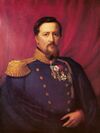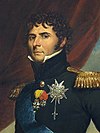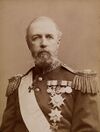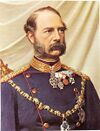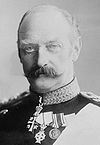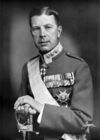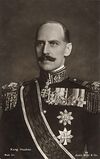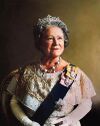Farenburg
Jump to navigation
Jump to search
| The Royal Dynasty of Farenburg Farenburg-Lupin-Veder House | |
|---|---|
| Royal house | |
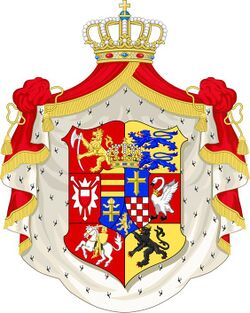 Coat of Arms of Royal Dynasty of Farenburgs | |
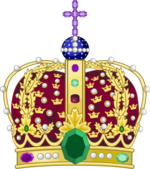 Crown of the Eastarland Empire | |
| Parent family | Lusenberg-Olgenburg |
| Country | Eastarland |
| Current region | Anteria |
| Place of origin | Brynefjord, Principality of Nedebrad |
| Founded | May 4, 1746 |
| Founder | Prince Kristian I |
| Current head | Emperor Frederik XI |
| Titles | Emperor of Eastarland King of Ōsallandet Princess of Tronsmark Prince of Nedebrad Grand Duchess of Fōlstmark |
| Style(s) | Your Imperial Majesty Your Royal Majesty Your Royal Highness |
| Members | Emperor Frederik XI Crown Princess Ester Crown Prince Stephen Prince Einar II Grand Duchess Anne-Lise I |
| Connected families | Farenburg-Meiss-Orin Frodrikson-Helmund Robertings Farenburg-Swettin |
| Traditions | Catholic Church |
| Motto | Deus est ex parte veritatis (God is on the side of truth) |
| Heirlooms | Imperial Crown of Eastarland |
| Estate(s) | The Royal Palace, Klausberg Kurtberg Castle, Ōsallandet Vinterpalasset Palace, Kongshelm Ludvikspalasset Palace, Sudsvoll |
The Farenburgs (Vohrenborg) are a ruling dynasty of monarchs of the Eastarland Empire since May 4, 1746. A branch of the discontinued Lusenberg-Olgenburg dynasty.
The full name is Farenburg-Lupin-Veder House (Vohrenborg-Lypin-Weder).
List of Farenburg Monarchs of Eastarland
| Monarch of Geordinia | Reign | Comments | |
|---|---|---|---|
(c. 1758 – 1821) |
1794 – 1821 | First Emperor of Eastarland. Under His leadership, the monarchs of the other lands of Eastarland agreed to join the Union. | |
(c. 1784 – 1850) |
1821 – 1848 | ||
(c. 1807 – 1879) |
1848 – 1850 1850 – 1879 |
Was regent to his father, Emperor Ingvar III. After his ascension to the throne in 1850, under the influence of the prominent politician and famous liberal Jonatan Farstad, he created the Constitutional Assembly and commissioned it to draft the Constitution. | |
(c. 1836 – 1892) |
1879 – 1892 | ||
(c. 1858 – 1912) |
1892 – 1912 | Emperor Kristian V, son of Emperor Lauritz I, became known as the Soldier Emperor. His military reforms, weapons reforms and warfare tactics made the Empire's army one of the best armies in the world. He personally commanded the army during the first Eastarland-Lusivite War. His maneuvers and reliance on artillery led him to victory in the decisive battle at Ustegam. | |
(c. 1879 – 1940) |
1912 – 1928 1935 – 1939 |
Emperor Kristian VI, son of Emperor Kristian V, was known from his youth for his eccentric behavior and scandalous lifestyle. He was briefly married, without the knowledge of the Emperor, to a commoner Unni Mikalsen. In the early years of Kristian's rule, corruption reached incredible proportions. Kristian himself became the richest landowner in the country, as well as co-owner of 34 industrial enterprises and several banks. In 1928, Kristian VI, with the support of the army, suspended the Constitution and dissolved parliament, established a personal dictatorship, and at the same time banned political parties and trade unions, soon after which he was ousted by General Krister Finstad and left the country, and his brother Gustaf became Emperor. | |
(c. 1886 – 1940) |
1928 – 1935 | After the coup of General Krister Finstad, the second son of Kristian V, Gustaf II, became Emperor. During his reign, he restored the operation of the Constitution, gathered Parliament and fought against corruption. In 1935, Kristian VI returned to the country and overthrew Gustaf with the support of the right-wing forces of Markus Hoff. And he puts him under house arrest in Kurtberg Castle, which was extremely displeased in Parliament. In 1940, Kristian VI summons Gustaf to Klausberg to appear before the States General. The Lusivetian terrorist threw a bomb at the entrance to the Parliament building, right at the feet of the Emperors who met there. Both died. | |
(c. 1906 – 1978) |
1940 – 1978 | Emperor Frederick X, son of Emperor Kristian VI, ascended the throne after the assassination of his father by a Lusivetian terrorist. He sent an ultimatum to the Principality of Lusiveс, in which he demanded the granting of powers to the Eastarland police to investigate in Lusivets and some other points known as the June ultimatum. After refusing to comply with 3 points out of 10, both sides announced the beginning of mobilization, which led to the beginning of the second Eastarland-Lusivite War, in which the Castarilian Empire intervened. As a result of this war, Eastarland completely accumulated Lusivetset, and Castarilia, which had not recovered after this war, disintegrated two years later. | |
(c. 1937 – 2012) |
1978 – 2006 | Empress Ester, daughter of Emperor Frederick X, is remembered for her social reforms. She gave women universal suffrage, the opportunity to study along with men, issued a decree establishing equal pay for men and women for the same work. Same-sex marriage was legalized. | |
(c. 1967) |
2006 – present | The current reigning Emperor of Eastarland, King of Ōsallandet, Count of Flogemund and Eishavn. Son of Empress Ester II. | |
